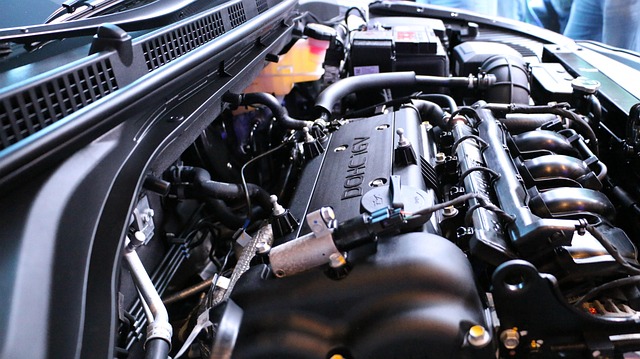Looking to register your car in California? This comprehensive guide walks you through every step, from understanding key requirements to securing your vehicle’s registration. First, grasp the essential rules and documents needed for the DMV visit. Learn why performing a VIN (Vehicle Identification Number) verification is crucial before applying. Then, follow our clear process for completing the application and paying fees. Finally, get your plates and confirm your vehicle’s official registration. Remember, proper dmv vin verification is a vital part of this process.
- Understand California Car Registration Requirements
- Gather Necessary Documents for DMV Visit
- Perform VIN Verification: Steps and Importance
- Complete Application and Pay Fees at DMV
- Receive Plate and Verify Vehicle Registration
Understand California Car Registration Requirements

Before registering your car in California, it’s crucial to understand the state’s specific requirements. The California Department of Motor Vehicles (DMV) mandates several steps for new and used vehicle registration, including a comprehensive vin verification process. This involves submitting the Vehicle Identification Number (VIN) for inspection to ensure the vehicle’s authenticity and history.
During the vin inspection or mobile vin verification process, the DMV checks for any outstanding issues related to the car’s title, such as liens, accidents, or theft. You’ll need to provide relevant documents and pass this step before finalizing the registration. These measures ensure that only legitimate vehicles are registered, protecting both buyers and sellers in California’s vibrant automotive market.
Gather Necessary Documents for DMV Visit

Before heading to the California DMV, ensure you have all the required documents for a smooth registration process. One crucial piece is the Vehicle Identification Number (VIN) verification, which can be done through various methods. You can opt for a traditional mobile vin inspection by visiting a certified inspector or utilize a mobile vin verifier app for a quick and convenient check. This step is essential as it ensures the vehicle’s history is clear and helps prevent potential issues with the registration.
Gathering these documents and ensuring your VIN is verified will save you time at the DMV. Remember to bring your car’s title, proof of insurance, and valid identification documents like a driver’s license or state ID. With these in hand, you’ll be prepared to navigate the registration process efficiently.
Perform VIN Verification: Steps and Importance

Before registering your car in California, performing a Vehicle Identification Number (VIN) verification is a crucial step. This process involves checking the VIN against the vehicle’s make, model, and year to ensure it matches the manufacturer’s records. You can do this through a DMV vin verification or by using a mobile vin verifier. Start by locating your car’s VIN, typically found on the vehicle’s certificate of sale, registration documents, or on the driver’s side door jamb. Then, follow these steps:
1. Visit a California DMV office and request a VIN verification form.
2. Fill out the necessary information accurately.
3. Submit the form along with any required documentation, such as proof of ownership and identification.
4. Wait for the DMV to process your request, which typically takes a few business days. Upon approval, you’ll receive a certificate confirming the VIN’s validity.
If you prefer a more convenient option, consider using a mobile vin inspection service. These professionals can perform the vin verification at your location, saving you time and effort. A valid and accurate VIN is essential for car registration in California, as it helps ensure that the vehicle matches the official records, preventing fraud and ensuring safety standards are met.
Complete Application and Pay Fees at DMV

After gathering all necessary documents, it’s time to head to the California Department of Motor Vehicles (DMV) office. Here, you’ll need to complete Form MV-52, which is the Application for Title and Registration. Make sure to fill it out accurately, providing detailed information about your vehicle, including its make, model, year, and unique Vehicle Identification Number (VIN). The DMV will also conduct a VIN verification process to ensure the vehicle’s history aligns with what you’ve declared.
Along with the application, you’ll need to pay the required fees. These can vary based on factors like the type of vehicle and whether you’re transferring ownership or registering a new purchase. Acceptable forms of payment are typically cash, check, or credit/debit card. Once your application is processed and fees paid, the DMV will issue your car’s registration, and you’ll be one step closer to hitting the road legally in California.
Receive Plate and Verify Vehicle Registration

After submitting your application and required documents to the DMV, it’s time for a crucial step: receiving your vehicle’s license plate and verifying its registration. The California DMV will issue a unique license plate that identifies your car. It’s essential to display this plate on your vehicle at all times while driving in the state.
To ensure everything is legitimate, consider using a mobile VIN verifier or conducting a VIN inspection. This process verifies that your vehicle’s details match the information on file with the DMV, including the Vehicle Identification Number (VIN). A mobile VIN verification service can be particularly convenient, allowing you to confirm registration and other vital details from the comfort of your home or even while picking up your plate.
Registering a car in California involves understanding key requirements, gathering essential documents, completing a straightforward application, and undergoing a mandatory DMV VIN verification process. By adhering to these steps and ensuring all necessary information is accurate, you can successfully register your vehicle, obtain license plates, and legally drive on California roads. Remember, proper registration not only complies with state laws but also ensures safety and accessibility for all drivers.
